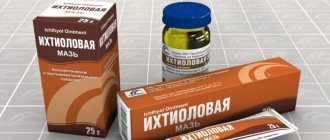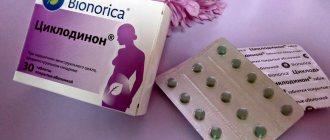Pharmacological properties of the drug Levitra™
A remedy for the treatment of erectile dysfunction. The physiological mechanism of penile erection is the relaxation of the smooth muscles of the corpus cavernosum and arterioles. During sexual stimulation, nitric oxide (NO) is released from the nerve endings of the corpus cavernosum, which activates the enzyme guanylate cyclase and increases the content of cyclic guanosine monophosphate (cGMP), resulting in relaxation of the smooth muscles of the cavernous body, causing an increase in blood flow to the penis. Vardenafil blocks specific phosphodiesterase type 5 (PDE-5), which causes the breakdown of cGMP. This enhances the action of endogenous NO in the corpus cavernosum during sexual arousal. Thus, when using Levitra, impaired erection is restored and a natural response to sexual stimulation is ensured. Vardenafil is rapidly absorbed after oral administration. Concentration in blood plasma after administration on an empty stomach reaches its maximum value within 30–120 minutes (on average after 60 minutes). Absolute bioavailability is about 15%. When taking vardenafil with fatty foods, its absorption rate decreases, the period to reach the maximum concentration increases to 60 minutes, the maximum concentration in the blood plasma decreases by an average of 20%; but there are no significant changes in AUC. When taking vardenafil with food containing no more than 30% fat, the pharmacokinetic parameters of the drug do not change. Vardenafil and its main metabolite are approximately 95% bound to plasma proteins, and this process is reversible and does not depend on the concentration of the drug. In the sperm of healthy men, no more than 0.00012% of the dose taken is determined 90 minutes after taking vardenafil. Vardenafil is metabolized primarily under the influence of the liver enzymes CYP 3A4 (main route), CYP 3A5 and CYP 2C9 (minor route). The total clearance of vardenafil is 56 l/h. After oral administration, vardenafil is excreted in the form of metabolites, mainly in feces (91–95% of the administered dose), and to a lesser extent in urine (2–6% of the dose). The half-life of vardenafil is on average 4-5 hours, the main metabolite M1 is about 4 hours. In healthy men aged 65 years and older, compared with younger patients (up to 45 years), an average increase in AUC of 52% was noted, but no significant decrease in the hepatic clearance of vardenafil was observed. The frequency of negative side effects of the drug does not depend on age. In individuals with mild, moderate and severe renal failure (creatinine clearance 55–80, 30–50 and ≤30 ml/min, respectively), the pharmacokinetics of vardenafil remain virtually unchanged. In patients with mild to moderate hepatic impairment, vardenafil clearance is reduced, and AUC and maximum concentrations increase in proportion to the degree of hepatic impairment.
Who makes Levitra?
Levitra is manufactured by Bayer Corporation (Germany), and the British pharmaceutical company Glaxo Smith Kline distributes it worldwide.
Levitra was developed and manufactured by the German company Bayer. The orange/yellow Levitra tablets bear the Bayer trademark in the form of a cross. Bayer also patented the Levitra trademark, owns the Internet domain Levitra.com, etc.
The British company GlaxoSmithKline has the world's best marketing infrastructure in the medical drug market. To effectively promote the new drug on the global market, Bayer teamed up with GlaxoSmithKline.
Here's how the two companies describe their relationship: “Levitra was developed and marketed jointly by Bayer and GlaxoSmithKline.”
Use of Levitra™
Inside, regardless of food intake. The recommended starting dose is 10 mg. The tablet should be taken 15–25 minutes before the start of sexual intercourse, but can be taken 4–5 hours before. To achieve the desired effect when using Levitra, adequate sexual stimulation is necessary. Taking into account the effectiveness and tolerability of the drug, the dose can be increased to 20 mg or reduced to 5 mg. The maximum recommended dose of Levitra is 20 mg, the frequency of administration is no more than 1 time per day. There is no need to adjust the dosage regimen in the elderly, patients with renal failure or minor liver dysfunction. In patients with moderately severe liver dysfunction, the clearance of vardenafil is reduced, so the initial dose of the drug should not exceed 5 mg/day. Taking into account the effectiveness and tolerability in the future, the daily dose of Levitra can be increased to 10–20 mg.
Is it possible to take Levitra with alcohol?
Judging by the research results, the positive effect of Levitra persists even after drinking moderate amounts of alcohol. Also, Levitra, like the drug Avana-100 (Avanafil), taken simultaneously with a small amount of alcohol, does not pose a danger to the body. However, no studies have been conducted on the combined effect of Levitra and large amounts of alcohol on the body, which is known to be one of the main causes of weak erections. So, if you plan to take Levitra, you should limit yourself to alcohol for a while.
Side effects of Levitra™
Usually well tolerated, side effects are transient and mild. The most common (10% of cases): headache, flushing (facial hyperemia); common (1–10%): dizziness, dyspeptic symptoms, nausea, nasal congestion; uncommon (0.1–1%): skin photosensitivity, hypertension (arterial hypertension), back pain, lacrimation; single (0.01–0.1%): arterial hypotension, myalgia, priapism.
Isolated cases of anterior ischemic optic neuropathy have been reported (resulting in decreased vision up to permanent loss), which is believed to be associated with the use of PDE-5 inhibitors, to which Levitra belongs. Most of the examined patients were at vascular risk (severe optic nerve congestion, age 50 years or more, diabetes, hypertension (arterial hypertension), cardiovascular diseases, hyperlipidemia and smoking). However, it has not been established whether these isolated cases are directly attributable to the use of PDE5 inhibitors in patients at vascular risk or whether they should be attributed to other factors.
conclusions
Despite the rather impressive list of adverse reactions, the total majority of them occurred in less than 1% of cases. Levitra is highly safe compared to alternative drugs. If you want to try an effective remedy for restoring potency, then this is one of the best options today. To protect yourself from unfavorable outcomes, you should carefully study the instructions for the pills, undergo a medical examination and consult a reliable doctor.
Leave a review for the article
Reviews to the article “Levitra (Vardenafil) contraindications, side effects, analogues, buy in Moscow | PoppersMag.net» 0 pcs.
Special instructions for the use of Levitra™
Drugs for erectile dysfunction are prescribed with extreme caution in cases of anatomical deformation of the penis, such as angulation, cavernous fibrosis (Peyronie's disease), as well as in diseases that contribute to the development of priapism (sickle cell anemia, multiple myeloma, leukemia or leukemia). Due to the lack of information about the safety of Levitra in patients of these groups, taking the drug is not recommended for severe liver dysfunction, end-stage kidney disease (if hemodialysis is necessary), severe arterial hypotension (resting systolic blood pressure ≤90 mm Hg) , unstable angina, after a hemorrhagic stroke or myocardial infarction (within the last 6 months), as well as with hereditary degenerative diseases of the retina (retinitis pigmentosa). Since Levitra has not been used in patients with a tendency to bleeding or in patients with peptic ulcers of the stomach or duodenum, the drug can be prescribed in such cases only after careful comparison of the expected benefits and potential risks. Before using vardenafil, it is necessary to assess the condition of the patient's cardiovascular system, since sexual activity is associated with a certain cardiac risk. For patients with congenital prolonged Q - T taking class Ia (quinidine, procainamide) or class III antiarrhythmic drugs (amiodarone, sotalol), Levitra is contraindicated. For patients over 65 years of age, it is not recommended to exceed a dose of 5 mg due to decreased clearance of vardenafil. Levitra is not intended for use by newborns, children or women.
In what cases should you not take Levitra?
• If you are allergic to Vardenafil;
• if you are taking ritonavir or indinavir, medicines to treat HIV;
• if you are taking medicines containing nitrates, such as glycerol trinitrate for angina;
• If you are over 75 years of age and are taking antifungal medications;
• If you have recently had a stroke or heart attack;
• If you have serious liver or heart problems;
• If you have kidney problems;
• If you have low blood pressure;
• If you have ever suffered from vision loss.
Levitra™ drug interactions
The safety and effectiveness of vardenafil in combination with other drugs to eliminate erectile dysfunction have not been established, therefore the use of such combinations is not recommended. A decrease in the clearance of vardenafil occurred with the simultaneous use of selective inhibitors of enzymes of the cytochrome P450 CYP 3A4 system (such as cimetidine, ketoconazole, itraconazole, indinavir, ritonavir, erythromycin). If combination with any of these drugs is necessary, the daily dose of Levitra should not exceed 5 mg. Concomitant use of vardenafil with α-adrenergic blockers may cause the development of symptomatic hypotension, so Levitra should be used no earlier than 6 hours after their administration. CYP 2C9 inhibitors (tolbutamide, warfarin), CYP 2D6 (selective serotonin reuptake inhibitors, tricyclic antidepressants), thiazides and thiazide-like diuretics, loop and potassium-sparing diuretics, ACE inhibitors, calcium antagonists, β-adrenergic blockers and inducers of CYP 450 metabolism (rifampicin , barbiturates) do not affect the pharmacokinetics of vardenafil. There were no signs of clinically significant interaction of vardenafil with tolbutamide (250 mg) or warfarin (40 mg), which are metabolized by CYP 2C9. A single dose of an antacid (magnesium/aluminum hydroxide) did not affect the bioavailability of vardenafil.
What does the name Levitra mean?
“Levitra” is just a made-up brand; the word “Levitra” itself has no meaning.
Although “Levitra” is a made-up word, I would like to explore the possible reasons why this word was chosen for the brand name.
Firstly, Levitra sounds like “levitation”, which means “to rise up”, “to soar”, and this is a great hint, since after taking Levitra your penis should rise. In addition, it can be assumed that the name Levitra comes from the French masculine pronoun “le” and the Latin “Vita”, which means life.
The name "Levitra" also has some similarities with the name "Viagra". “Levi-ra,” like “Via-ra,” ends in “ra” and both words contain three syllables.
When a new drug is released, it is usually given two names. General name and name of the trademark (brand). Levitra is the brand name, while Vardenafil is the generic name.
The brand is used for marketing because the name is easy to remember and pronounce for consumers and physicians. Large pharmaceutical companies spend tens of millions of dollars on advertising their new drugs, and therefore, huge amounts of money are also spent on developing and promoting their brands. The name "Levitra" was proposed by The Brand Institute, which is also the creator of the brands Lipitor, Relenza, Allegra D, Sarafem and Celebrex.
Bayer patented the name Levitra on February 8, 2000. Around the same time, the company received patents for the names “Afortix” and “Nuviva”. It is possible that these were other possible names for the new drug.
Reviews from men
Igor, 33 years old: “Levitra works well and lasts a long time, but there are side effects: the eyes seem to fill up, they begin to ache from the inside, and then a headache comes along.”
Ilya, 36 years old: “In my opinion, Levitra is much stronger than Viagra, only this effect appears after about 3 hours. I didn’t have such strength even at 20 years old. A dosage of 10 mg is enough for me.”
Anton, 45 years old: “It’s better to take Levitra a few hours before. For example, if sex is planned in the evening, then at lunchtime. This is my personal observation. “Just in case” there is no need to take pills, since discharge will still be required.”
Sergey, 35 years old: “After the divorce, I was struck by STOSN syndrome. The drug “Levitra ODT” (from the “melts in your mouth” series) turned out to be an effective remedy. I solved the problem - during the evening-night there were 5 contacts, and without tension (I want - it’s worth it, I don’t want - it’s not worth it). I took 10 mg only 2 times on weekends, but after a couple of weeks side effects began: a rash on the bends of my elbows. I switched to regular Levitra and conjunctivitis began. It’s a pity that there’s such intolerance.”
Men's review of Levitra
Release form and composition
Dosage form of Levitra - tablets: biconvex, round, film-coated with a rough surface, from pale orange to grayish-orange, with an engraving applied by embossing - “5”, “10” or “20” on one side and a brand name Bayer cross to another (1 or 4 tablets in a blister, 1 blister in a cardboard box).
The active ingredient is vardenafil (in the form of trihydrate hydrochloride), the content of 1 tablet embossed “5”, “10” or “20” is 5, 10 or 20 mg, respectively.
Additional components:
- Excipients: colloidal anhydrous silicon dioxide, crospovidone, microcrystalline cellulose, magnesium stearate;
- Shell: titanium dioxide, red iron oxide, macrogol 400, yellow iron oxide, hypromellose.









